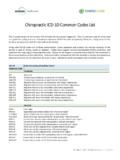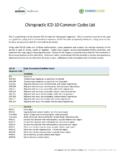Transcription of Physiotherapy scoliosis-specific exercises – a ...
1 REVIEWOpen AccessPhysiotherapy scoliosis - specific exercises a comprehensive review of seven majorschoolsHagit Berdishevsky1* , Victoria Ashley Lebel2 , Josette Bettany-Saltikov3, Manuel Rigo4, Andrea Lebel5,Axel Hennes6, Michele Romano7,8, Marianna Bia ek9, Andrzej M hango9, Tony Betts10, Jean Claude de Mauroy11and Jacek Durmala12 AbstractIn recent decades, there has been a call for change among all stakeholders involved in scoliosis management. Parents ofchildren with scoliosis have complained about the so-called wait and see approach that far too many doctors use whenevaluating children s scoliosis curves between 10 and 25 . Observation, Physiotherapy scoliosis specific exercises (PSSE)and bracing for idiopathic scoliosis during growth are all therapeutic interventions accepted by the 2011 InternationalSociety on scoliosis Orthopaedic and Rehabilitation Treatment (SOSORT). The standard features of these interventionsare: 1) 3-dimension self-correction; 2) Training activities of daily living (ADL); and 3) Stabilization of the corrected is part of a scoliosis care model that includes scoliosis specific education, scoliosis specific physical therapy exercises ,observation or surveillance, psychological support and intervention, bracing and surgery.
2 The model is oriented to thepatient. Diagnosis and patient evaluation is essential in this model looking at a patient-oriented decision according toclinical experience, scientific evidence and patient s preference. Thus, specific exercises are not considered as analternative to bracing or surgery but as a therapeutic intervention, which can be used alone or in combination withbracing or surgery according to individual indication. In the PSSE model it is recommended that the physical therapistwork as part of a multidisciplinary team including the orthopeadic doctor, the orthotist, and the mental health careprovider - all are according to the SOSORT guidelines and scoliosis Research Society (SRS) philosophy. From clinicalexperiences, PSSE can temporarily stabilize progressive scoliosis curves during the secondary period of progression,more than a year after passing the peak of growth.
3 In non-progressive scoliosis , the regular practice of PSSE could produce a temporary and significant reduction of the Cobb angle. PSSE can also produce benefits insubjects with scoliosis other than reducing the Cobb angle, like improving back asymmetry, based on 3 Dself-correction and stabilization of a stable 3D corrected posture, as well as the secondary muscle imbalanceand related pain. In more severe cases of thoracic scoliosis , it can also improve breathing paper will discuss in detail seven major scoliosis schools and their approaches to PSSE, including theirbracing techniques and scientific evidence. The aim of this paper is to understand and learn about thedifferent international treatment methods so that physical therapists can incorporate the best from each intotheir own practices, and in that way attempt to improve the conservative management of patients withidiopathic scoliosis .
4 These schools are presented in the historical order in which they were developed. Theyinclude the Lyon approach from France, the Katharina Schroth Asklepios approach from Germany, the Scientific(Continued on next page)* Equal contributors1 Conservative Care for Spine and scoliosis , ColumbiaDoctors Midtown,Columbia University Medical Center, New York, NY, USAFull list of author information is available at the end of the article 2016 The Author(s).Open AccessThis article is distributed under the terms of the Creative Commons Attribution License ( ), which permits unrestricted use, distribution, andreproduction in any medium, provided you give appropriate credit to the original author(s) and the source, provide a link tothe Creative Commons license, and indicate if changes were made. The Creative Commons Public Domain Dedication waiver( ) applies to the data made available in this article, unless otherwise al.
5 scoliosis and Spinal Disorders (2016) 11:20 DOI (Continued from previous page) exercise Approach to scoliosis (SEAS) from Italy, the Barcelona scoliosis Physical Therapy School approach(BSPTS) from Spain, the Dobomed approach from Poland, the Side Shift approach from the United Kingdom,and the Functional Individual Therapy of scoliosis approach (FITS) from recent decades, there has been a call for change amongall stakeholders involved in scoliosis management. Parentsof children with scoliosis have complained about the so-called wait and see approach that far too many doctorsuse when evaluating children sscoliosiscurvesbetween10 and 25 [1]. Numerous physical therapists have reportedthat children with scoliosis and their parents are reacting totheir lack of empowerment as they wonder how to helpthemselves beyond simply waiting and bracing. Physicaltherapists, most of whom are still inadequately educatedand equipped to provide quality scoliosis treatment, havesearched for new treatment methods.
6 Orthotists haverecognized that traditional braces lack the ability to make3D corrections, producing flat back or other poor cosmeticchanges, and are looking for more effective options. Finally,doctors have sought out alternatives to help patients whoare not good candidates for surgery [2].The Society of scoliosis Orthopedic Rehabilitation andTreatment (SOSORT) was founded in 2004 in reactionto this growing awareness. SOSORT promotes and en-courages conservative, evidence-based medicine regard-ing scoliosis and provides education, guidelines andconsensus about treatment options to people with scoli-osis [3]. Every scoliosis approach or school around theworld subscribes to SOSORT s principles and shares acommon mission. The shared goal is not simply to lookat the spine in the coronal plane but to look at theaffected subject and family under a more holistic psy-chosocial model, where present and future quality of lifeis the main uses the term Physiotherapy scoliosis SpecificExercises (PSSE) in connection with all of the schoolsrepresented within the organization.
7 The effectiveness ofPSSE in treating patients with Adolescent IdiopathicScoliosis (AIS) has been demonstrated by recent a Cochrane review published in 2012 [4] reported alowtoverylowqualityofevidencefortheprop ositionthatPSSE was effective in improving Cobb angle, angle of trunkrotation, pain and quality of life, since the time of thatreview, four randomized controlled trials (RCTs), which aregenerally recognized as the highest level of evidence forprimary studies, have provided strong proof that PSSE areindeed effective for treating AIS patients with mild andmoderate curves. The four RCTs were conducted in differ-ent parts of the world in Italy by Monticone et al. [5](2013), in Canada by Schreiber et al. [1] (2015), inEngland by Williamson et al. 2015 [6], and in Turkey byKuru et al. [7] (2015) and are summarized in the bodyof this major scoliosis schools and their approaches toPSSE, including their bracing techniques, will be dis-cussed in detail in this paper.
8 The differences betweenthe schools are related to PSSE used by each school. Thepurpose of this paper is not to determine which scoliosisschool and treatment approach is superior to the , the aim is to understand and learn about thedifferent treatment methods around the world so thatphysical therapists can incorporate the best from eachinto their own practices, and in that way attempt toimprove the conservative management of patients withidiopathic schools are presented in the historical order inwhich they were developed. They include the Lyonapproach from France, the Katharina Schroth Asklepiosapproach from Germany, the Scientific exercise Approachto scoliosis (SEAS) from Italy, the Barcelona ScoliosisPhysical Therapy School approach (BSPTS) from Spain,the Dobomed approach from Poland, the Side Shiftapproach from the United Kingdom, and the FunctionalIndividual Therapy of scoliosis approach (FITS) Lyon approach (France)IntroductionThe Lyon school of Physiotherapy for scoliosis , managedby Dr.
9 Jean Claude de Mauroy, the head of the ortho-pedic medicine department at Clinique du Parc, Lyon,France (Fig. 1), is one of the oldest physiotherapyschools in France and one of the first schools to be inte-grated into the Faculty of Medicine program in is an integral part of the Lyon approachto the management of scoliosis in conjunction with cast-ing and Gabriel Pravaz, an orthopedic surgeon, created thefirst orthopedic Physiotherapy center in Lyon two cen-turies ago. In the middle of the 20th century, Dr. PierreStagnara established an organized nonsurgical approachto manage scoliosis with casts and braces, and in 1947he created the Lyon brace. More recently, the ARTbracehas been developed, which obviates the need for a plastercast [8]. Although the Lyon method is primarily focusedon the use of bracing and in the recent past on bothBerdishevskyet al. scoliosis and Spinal Disorders (2016) 11:20 Page 2 of 52casting and bracing it includes scoliosis specific exer-cises to support of treatmentThe Lyon method traditionally combined PSSE with theLyon brace and casting, and more recently has com-bined PSSE with bracing alone in the form of the newLyon ARTbrace (Asymmetrical Rigid Torsion brace).
10 Physiotherapeutic treatment includes 3D mobilization ofthe spine, mobilization of the ilio-lumbar angle (lumbarscoliosis), patient education, and activities of daily living,including correction of the sitting indications, goals and age specificsThe 2011 SOSORT Guidelines provide clear, scientificindications regarding what type of treatment (observation,physical therapy, bracing, surgery) is appropriate for patientswith scoliosis [9]. Under the Lyon approach, the treatmentis more specifically determined by the type of scoliosis ;chaotic or linear [10]. Chaotic scoliosis is a true 3D struc-tural deformity of the spine, which occurs in % of adolescents with scoliosis curves <20 Cobb is a dynamic scoliosis , which can be influenced bymany environmental factors. Because of the uncertainty ofits progression, chaotic scoliosis can best be described bydeterministic chaos. While, according to Newton sLawofGravity, we can predict where the apple that falls from a treewill land, we cannot similarly predict where a leaf that fallsfrom a tree will land.



